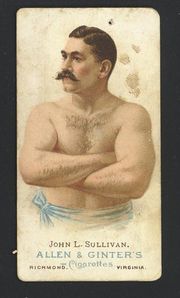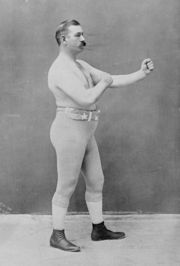John L. Sullivan
| John L. Sullivan | |
|---|---|
 John L. Sullivan in his prime. |
|
| Statistics | |
| Nickname(s) | Boston Strong Boy |
| Rated at | Heavyweight |
| Height | 5 ft 10½ in (1.79 m) |
| Reach | 74 in (188 cm) |
| Nationality | |
| Birth date | October 15, 1858 |
| Birth place | Roxbury, Massachusetts, USA |
| Death date | February 2, 1918 (aged 59) |
| Death place | Mattapan, Massachusetts, USA |
| Stance | orthodox |
| Boxing record | |
| Total fights | 41 |
| Wins | 38 |
| Wins by KO | 32 |
| Losses | 1 |
| Draws | 1 |
John Lawrence Sullivan (October 15, 1858 – February 2, 1918), also known as the Boston Strong Boy, was recognized as the first heavyweight champion of gloved boxing from February 7, 1881 to 1892, and is generally recognized as the last heavyweight champion of bare-knuckle boxing under the London Prize Ring rules. He was the first American sports hero to become a national celebrity and the first American athlete to earn over one million dollars.
Contents |
Early life
He was born in Roxbury, Massachusetts (now a part of Boston) to Irish immigrant parents, Michael Sullivan from Abbeydorney, County Kerry and the former Catherine Kelly from Athlone, County Westmeath. Sullivan was nicknamed The Boston Strongboy. As a youth he was arrested several times for participating in bouts where the sport was outlawed, and he went on exhibition tours offering people money to fight him. In 1879, when he challenged anyone in America to fight him for $500, Sullivan had won over 450 fights in his career.
In 1883 - 1884 Sullivan went on a coast-to-coast tour by train with five other boxers. It was scheduled to comprise 195 performances in 136 different cities and towns over 238 days. To help promote the tour, Sullivan announced that he would box anyone at any time during the tour under the Queensberry Rules for $250. He knocked out eleven men during the tour.
Championships


In Sullivan's era, no formal boxing titles existed. He became a champion after defeating Paddy Ryan in Mississippi City, near Gulfport, Mississippi on February 7, 1882. Modern authorities have retroactively labelled Ryan the "Heavyweight Champion of America", but he could certainly not be considered as much a "world champion" as Sullivan, having never contended internationally. Depending on the modern authority, Sullivan was first considered world heavyweight champion either in 1888 when he fought Charley Mitchell in France, or the following year when he knocked out Jake Kilrain in round 75 of a scheduled 80-round bout. When the modern authorities talk of the heavyweight championship of the world, they are probably referring to the championship belt presented to Sullivan in Boston on August 8, 1887. The belt was inscribed Presented to the Champion of Champions, John L. Sullivan, by the Citizens of the United States. Its centerpiece featured the flags of the US, Ireland, and the United Kingdom.
Mitchell came from Birmingham, England and fought Sullivan in 1883, knocking him down in the first round. Their second meeting took place in 1888 on the grounds of a chateau at Chantilly, France in driving rain. It went on for more than two hours, at the end of which both men were unrecognisable and had suffered much loss of blood; neither could lift his arms to punch and the contest was considered a draw.
The local gendarmerie arrived at this point and managed to arrest Mitchell, who spent the next few days in a cell and was later fined by the local magistrate, boxing being illegal in France at that time. Sullivan managed to evade the law, swathed in bandages, and was taken back across the English Channel to spend the next few weeks convalescing in Liverpool. Mitchell acted as Sullivan's corner man for many years after.
The Kilrain fight



The Kilrain fight is considered to be a turning point in boxing history because it was the last world title bout fought under the London Prize Ring rules and therefore the last bare-knuckle heavyweight title bout. It was also the first American sporting event to receive national press coverage.
For the first time, newspapers carried extensive pre-fight coverage, reporting on the fighters' training and speculating on where the bout would take place. The center of activity was New Orleans, but the governor of Louisiana had forbidden the fight in that state. Sullivan had trained for months in Belfast, New York under trainer William Muldoon, whose biggest problem had been keeping Sullivan from liquor.
Rochester reporter Arch Merrill commented that occasionally Sullivan would "escape" from his guard, and the cry was heard in the village, "John L. is loose again. Send for Muldoon!" Muldoon would snatch the champ away from the bar and take him back to their training camp.
On July 8, 1889, an estimated 3000 spectators boarded special trains for the secret location, which turned out to be Richburg, a town just south of Hattiesburg, Mississippi. The fight began at 10:30 the following morning, and it looked as if Sullivan was going to lose, especially after he vomited during the 44th round. But the champion got his second wind after that, and Kilrain's manager finally threw in the towel after the 75th round.
Later career
Undefeated at that point, Sullivan did not defend his title for the next four years.
Sullivan agreed to defend his title in 1892, against challenger "Gentleman Jim" Corbett. The match was on 7 September in New Orleans, Louisiana. It began at 9PM in the electrically illuminated Olympic Club in the city's Bywater section, the venue filled to its 10,000 person capacity despite hefty ticket prices ranging from $5 to $15 (approximately $117 to $353 in 2009 dollars). The heavyweight contest occurred under the Marquess of Queensberry rules, but it was neither the first title fight under those rules nor was it the first title fight using boxing gloves. Corbett was younger, faster and his boxing technique enabled him to dodge Sullivan's crouch and rush style. Sullivan was counted out in the 21st round, and Corbett declared the new champion. When Sullivan was able to get back to his feet, he announced to the crowd, "if I had to get licked I'm glad I was licked by an American". [1]
Sullivan is considered the last bare-knuckle champion because no champion after him fought bare-knuckled. However, Sullivan had fought with gloves under the Marquess of Queensberry rules as early as 1880 and he only fought bare knuckle three times in his entire career (Ryan 1882, Mitchell 1888, and Kilrain 1889). His bare-knuckle image was created because both his infrequent fights from 1888 up to the Corbett fight in 1892 had been bare-knuckle.
Retirement

Sullivan retired to Abington but appeared in several exhibitions over the next 12 years, including a three-rounder against Tom Sharkey and a final two-rounder against Jim McCormick in 1905. He continued his various careers outside boxing such as stage actor, speaker, celebrity baseball umpire, sports reporter, and bar owner.
Overweight and unhealthy from a long life of overindulging in food and drinks as well as from the effects from prizefighting, Sullivan died at age 59 and is buried in the Old Calvary Cemetery in Mattapan, now a neighborhood of Boston.
Legacy
- He was inducted into the International Boxing Hall of Fame in 1990, as a member of the hall's original class. He had a record of 35 wins, 1 loss and 2 draws, with 30 wins by knockout, though many sources disagree on his exact record.
- He is known to have been an autograph signer, and there are many items including documents and photos known to bear his signature, which are valued in the hundreds of dollars. A photo with a facsimile autograph surfaced decades ago on books, magazines and in novelty stores, and has been widely circulated.
- The male nightwear garment known as 'Long Johns' are said to be named because he often boxed in an outfit that looked like long underpants.
- The barn where Sullivan trained still stands in the small town of Belfast, NY.
- There is a non-player character in a computer game Fallout 2 named John L. Sullivan. He is a retired boxer of Irish descent and he can teach the player "pugilism", which he calls "the manly, uh, and womanly art of hand-to-hand combat".
See also
- List of bare-knuckle boxers
References
- Michael Isenberg, John L. Sullivan and His America, 1988 (ISBN 0-252-06434-8)
- Arch Merrill, A River Ramble, 1943
- JOHN L SULLIVAN DIES SUDDENLY at www.boxinggyms.com Announcement of Sullivan's death by the Rome New York Daily Sentinel
Further reading
- John Lawrence Sullivan, Dudley Allen Sargent. Life and reminiscences of a 19th century gladiator. Boston: J.A. Hearn & co., 1892. Google books
- Washington Post; July 30, 1905; by John L. Sullivan; "'Your hands are too big; you'll never make a boxer,' was one of the bits of discouragement passed to me when I was beginning to attract notice as a puncher. That was the popular notion at that time, because Sayers, Heenan, Yankee Sullivan, and some other good men who had made their tally and passed up had small hands."
External links
- Professional boxing record for John L. Sullivan from BoxRec
- The Boston Strongboy
- Yesterday's News An 1883 newspaper account of a Sullivan exhibition in St. Paul, Minn.
| Awards and achievements | ||
|---|---|---|
| Preceded by Paddy Ryan |
World Heavyweight Champion 1882 – 1892 |
Succeeded by James J. Corbett |